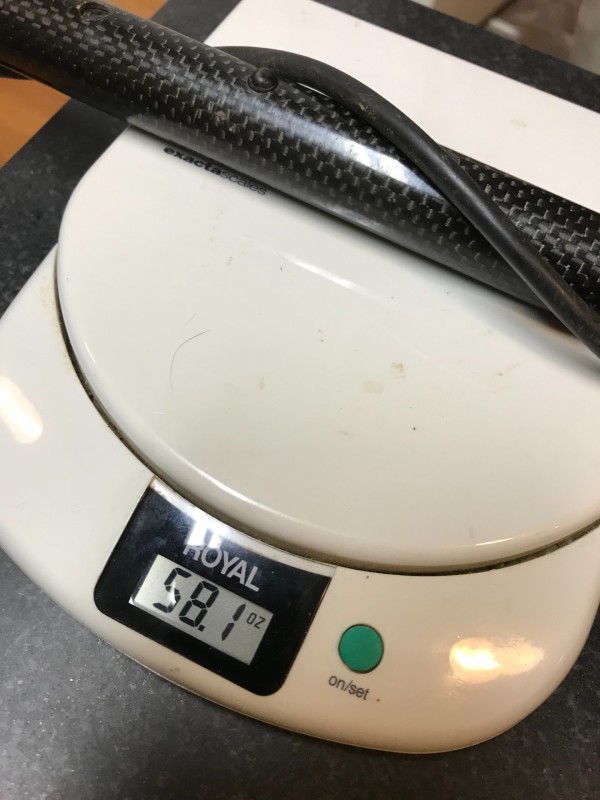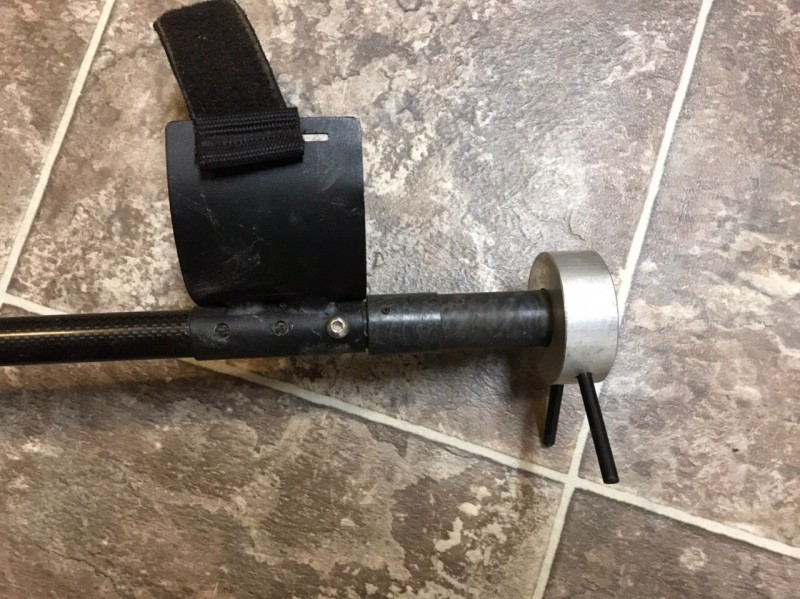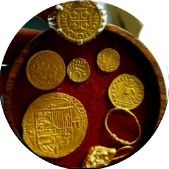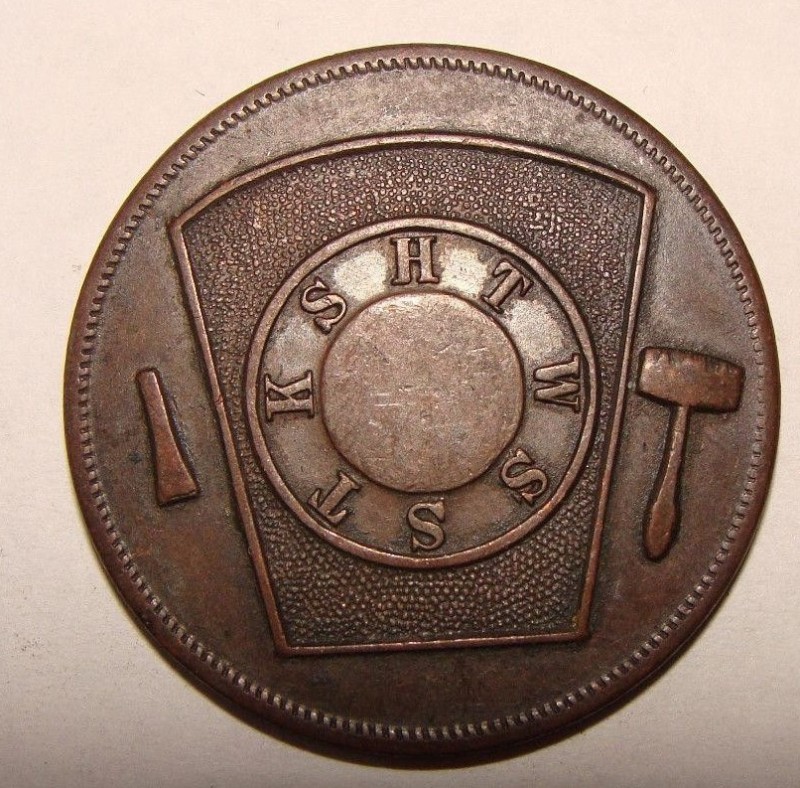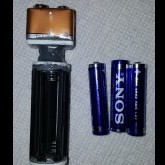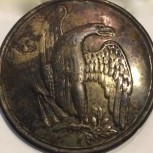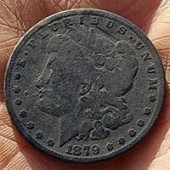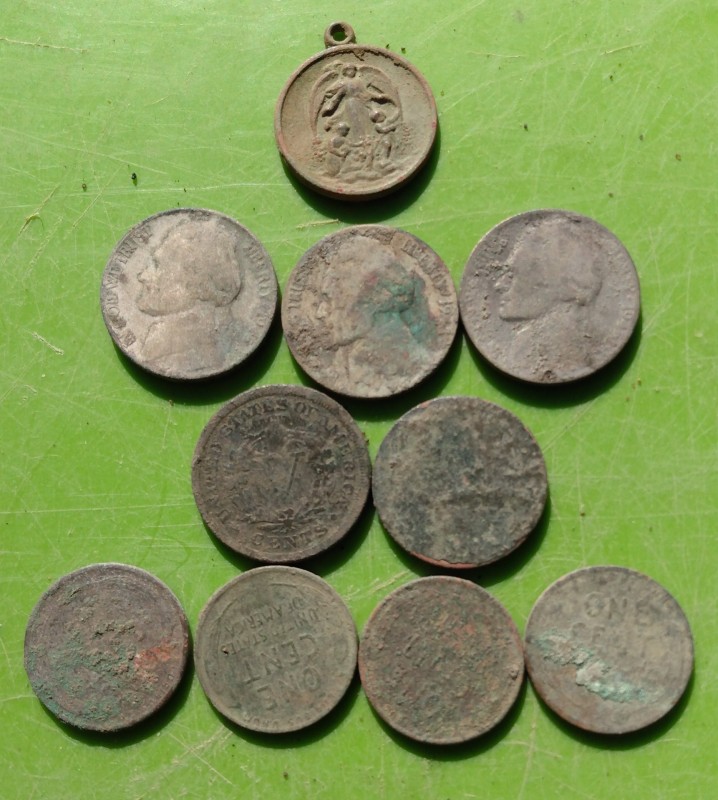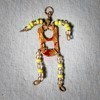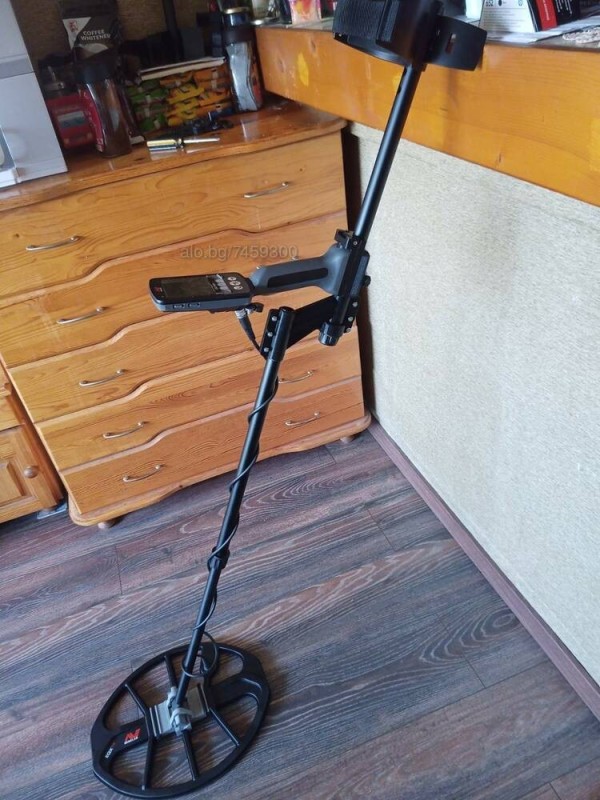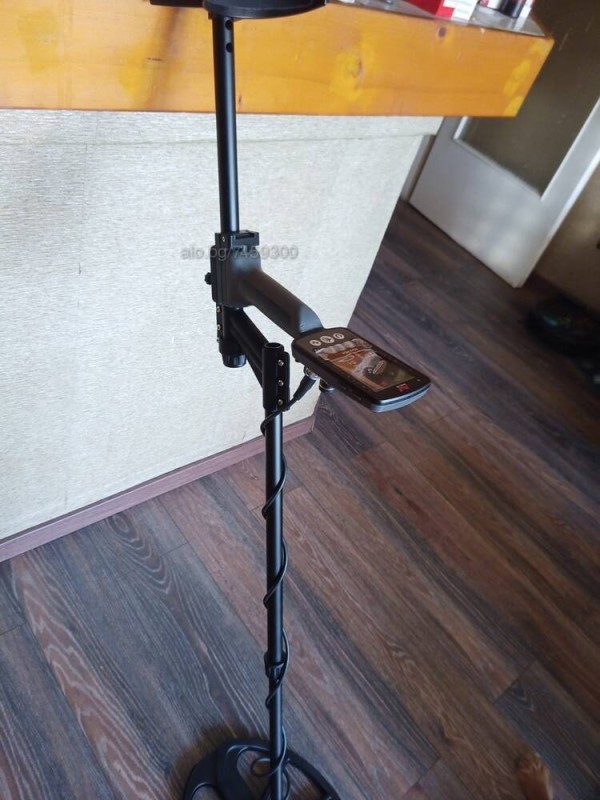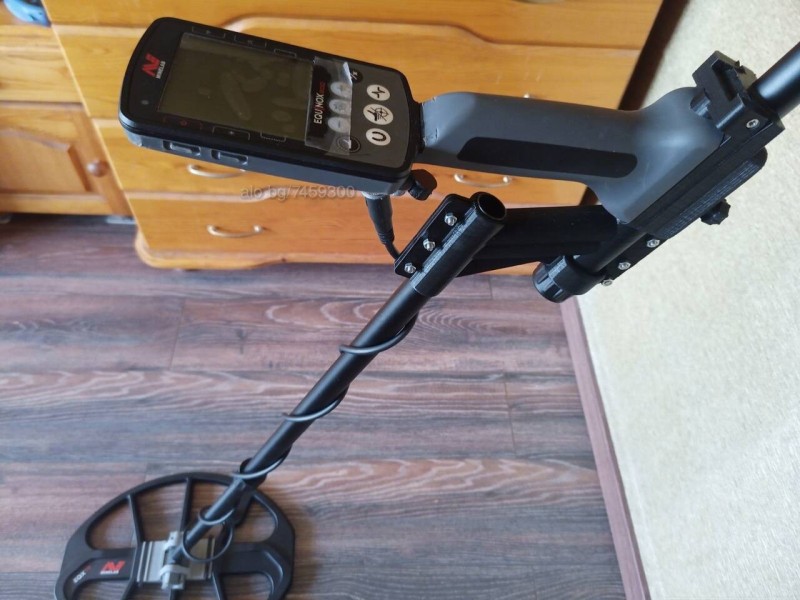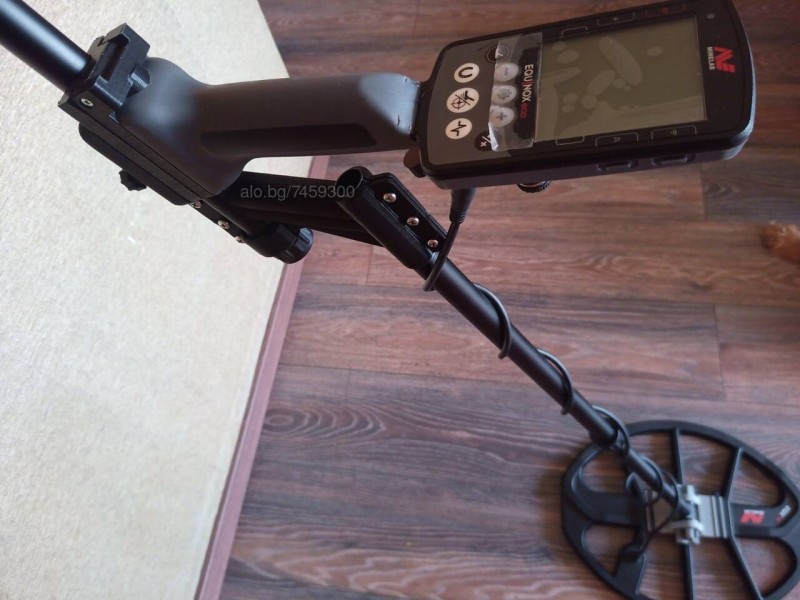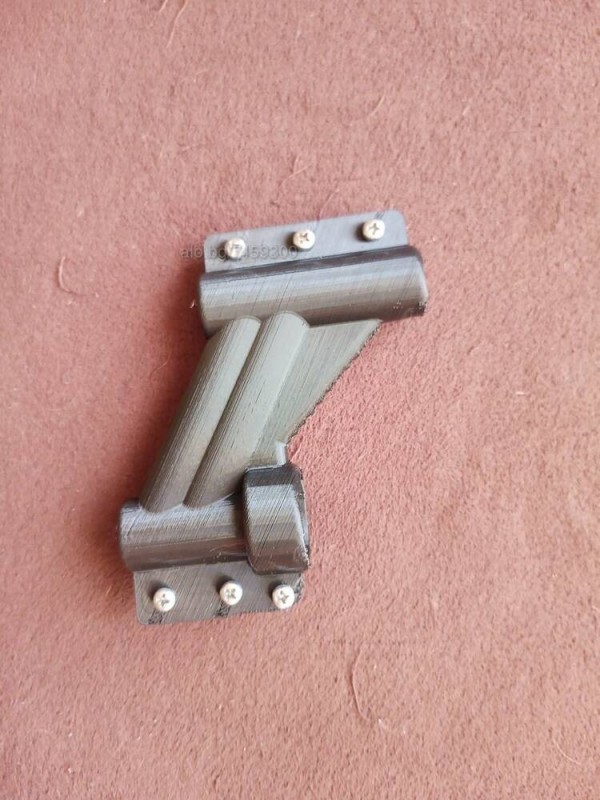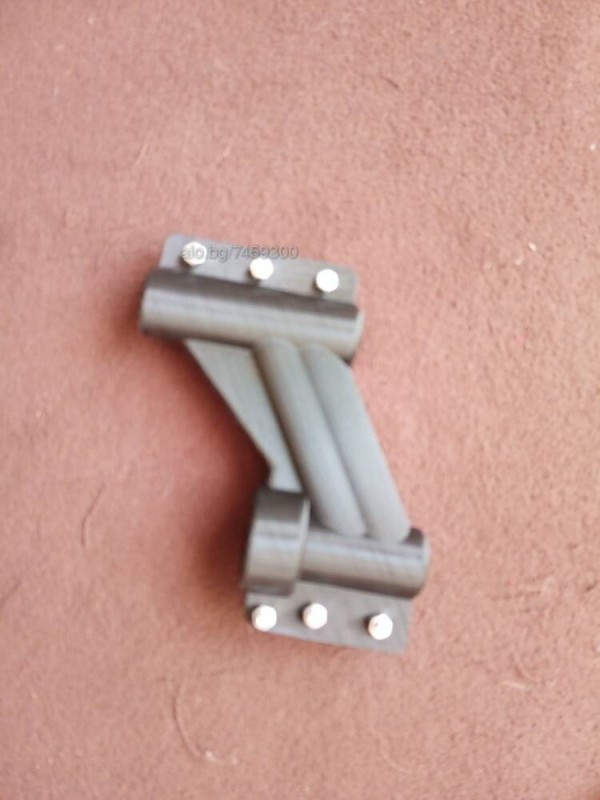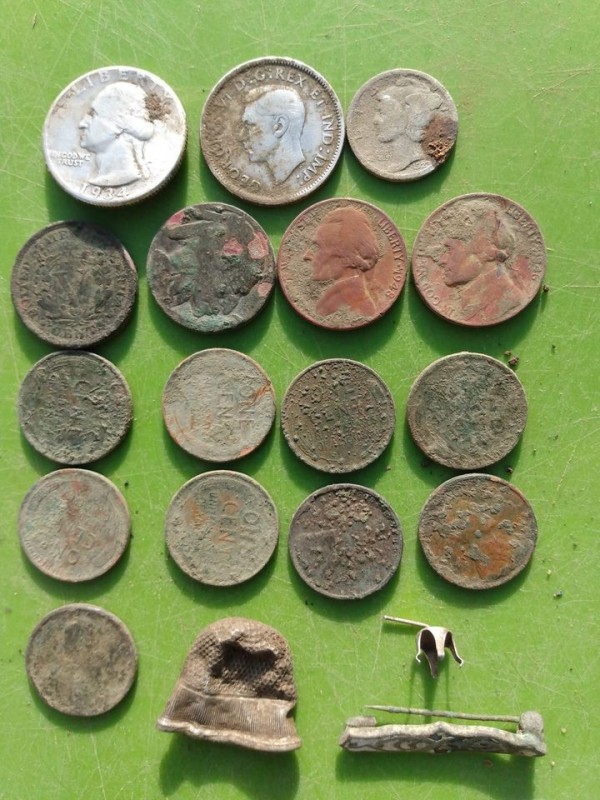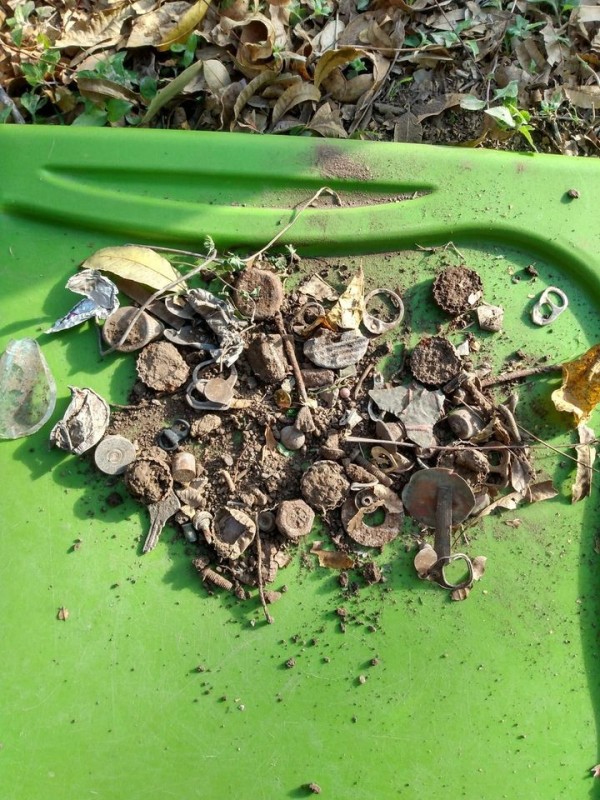Search the Community
Showing results for tags 'minelab equinox'.
-
I just weighed my nox. It has an Anderson carbon fiber shaft and their metal armrest, home made counterweight, deanos control box cover, and a coil ear stiffener. Guess how much it weighs? Check pic below for the answer. The counterweight makes it more comfortable for me to swing but it’s still heavy, especially after 4 or 5 hours. Now the deus II can be set up in several configurations, but if we go with the heaviest setup with the nine inch coil which is what I have on pre order, I believe it’s around 1 kilogram which is 35.27 ozs. That’s a 22.83 oz savings!For those of you using a counterweight, have you ever weighed the entire rig? If so, please post up some weights.
-
A roman iron slag from smelting. Very highly mineralized! Some information about these bad things: https://glevumdetecting.com/history/roman_iron_making.htm Back here we have some good areas full of these things!
-
For the 3rd time in the last four years Southern Indiana had a mild December and I was able to detect 14 days. Here are the highlights of my last 6 hunts -- bracketing Christmas -- 20-->27 Dec.: I'll start with the coins (but not in the order shown). 1929-plain Merc (never been disappointed finding a Merc!), 1943-P Warnick, 1936-D Buffalo nickel (very common date+MM), well worn Buffie with a -D mintmark, either a 1916 or 1918 (or, is it too much to ask, 1918/17 overdate?). Correction: I got a better magnification on it and it's a 1915-D (not the D/D overmintmark, just the standard die strike). I'll expound on the 1891 Indian Head Penny a little later. (Note: if you don't want to read my long-winded details of the relics, please go to the last couple paragraphs which describe the large token. I need help with that one.) The token with the hole (before I put mineral oil on it) appears to be copper due to its green color, but maybe brass on bronze. I recall its dTID on the ML Equinox was low 20's (between zinc penny and aluminum screwcap), so probably brass. One side says "THIS TOKEN HAS NO CASH OR TRADE VALUE". I've yet to figure out what is printed on the reverse but that is hopefully more revealing of its origin. At this point I think it could have been made anywhere from the 1920's all the way up to the 1960's based both its looks, patina, and depth (~7"). The tiny buckle may be from a child's shoe. It dTID'ed in the USA 5 cent 'Nickel' zone of 12-13. The two pieces of junk jewelry -- ultracheap earring and crushed gold plated copper(?) ring came it 20-21. (I was hoping for IHP's....) The item at the bottom is non-magnetic. On one side it says 'DUCKBILL' and the other side has a patent number. You can see a rusty steel pin near the junk gold-plated ring -- some kind of pivot point I think. It has an opening on the left end but nowhere else. It appears to be a crude piercing or puncturing tool. If I really want to dig into it I will need to clean up the other side so I can read the patent number and then do a patent lookup -- I've done those before. Not sure I care enough to go to that trouble, but it would give me a better idea of its age (and thus more info of the site). On one of my hunts I hit a part of the park I hadn't done any searching, thinking it was barren of old coins. In the first 10 minutes I got a Buffalo nickel (don't remember which one). 3+ hours later with little more to show (maybe a Wheat Cent or two) I was getting ready to wrap up, hoping for one more goodie. About 10 m. from where I found the Buffie I got a signal which just barely gave a 20 dTID (my first high tone bin) but mostly 18 and some 19. It was a weak enough signal that I thought it might be fairly deep and thus not a recent drop. I don't remember the depth but somewhere in the 5-7 inch range and out popped the 1891 IHP. I know others (e.g. F350Platinum) have gotten IHP's with low dTID's but mine are almost always 20-22 (as are most of my oldest Wheat pennies). Since ring tabs (missing the beavertail) tend to show 18 in my experience, I've avoided 14-18 (14 being modern 'racetrack' shape pulltabs). Whenever I get an anomalous dTID like this I wonder how many keepers I've left in the ground.... After that day I lowered my lowest high tone bin to 19 but have yet to dig another IHP (quite of the hated corroded Zincolns, though). The biggest surprise is the large token at the upper left. In the middle it says "ONE PENNY" and the rest of the printing: FRANKLIN CHAPTER NO. 20, R.A.M. CHAPTERED MAY 7TH 1858 OROVILLE, CALIF. (I didn't photo the reverse but here is what it looks like -- this photo from Google Images): A bit of internet searching revealed that 'R.A.M.' stands for 'Royal Arch Masonry' which I think is part of the well known Freemasonry, but a subgroup that has its own meetings, lodges, etc. Here's a Wikipedia writeup. From what I can tell (again from the internet), lots of chapters had these so-called 'pennies' issued with their chapter location and number printed on them as far back as the 2nd half of the 19th Century. There was (and probably still is) a fairly widespread practice of collecting them. So how, why, and when did this one travel 2000+ miles from the heart of the California Motherload to a muni park in Indiana? That I will never know. It dTID'ed in the mid-30's, consistent with a USA large cent or large USA 90% silver coin (half or dollar). Based upon that I think it's pure copper. Given its condition and where it was located -- about 6" deep and maybe 18" from a sidewalk (probably poured in the 60's or 70's, with associated nearby backfill -- I assume it's been in the ground somewhere very roughly around 30 years. I found an obituary of an Oroville R.A.M. chapter member who died recently (2019) at the age of ~90 so it was still in existence after WWII, and is maybe still in existence. Anyone know any more than that? Has anyone of you ever find a Masonic Penny while detecting?
-
For my end-of-the-year rush I'm concentrating on my (by far) best current site, what I've been calling "The Wheatfield" because of how many Wheat Cents it's produced (relative to my other sites). Equinox w/11" coil in Park 1, Recovery Speed = 4; Iron Bias F2 = 0, gain = 24. I start with a photo and go into detail from there: The cruddy looking 35% silver 'Warnick' was a surprise when I got home and cleaned up my 'modern' coins. Around here Warnicks tend to reveal themselves immediately because the chemicals in the ground clean them up to look more/less like other silver coins (well, not quite as pretty as the quarter shown). Even after gently washing in water this one is butt ugly. 1943-P (most common of all the Warnicks) and fairly well warn, too. Still, almost 80% as much silver as a 90% silver dime. The 1952 plain (= Philadelphia minted) Washington quarter is only my second quarter this year (other one also from the Wheatfield, but it was an 1895-S Barber) was about 6" deep and showed jumpy dTID with high value (centroid ~31 which is where air tests would put it, but plenty of high 20's and low 30's as well when in the ground). Although I hoped for a silver coin, no way did I count on it being even a good find as I've probably hit many 10's of targets with dTID's in this range that turned out to be worthless. (Thumbtacks are the cleanest and most promising signals!). The ring is marked 'sterling' and looks to be either a child's size or maybe for a woman's pinkie. I don't know what that is right below it but I'm thinking it might be made of aluminum alloy. It is brittle, bent, and broken but quite decorative. The remaining two items are my 'whatzits?' that I hope someone here will recognize/identify. The small item with a bird is anodized aluminum alloy (dyed to look like gold). I did an Archimedes method specific gravity determination. It has a central post and a flat disk back similar in size to the front. It must be made to fit into a buttonhole type of opening, but looks too small to be a cufflink. Possibly a lapel pin. Could it be for display in either a cap or a over-the-breastpocket ribbon sash (e.g. military)? Anyone recognize the emblem? Could it be something worn by an airplane pilot? It has no printing whatsoever. Most surprising was its signal. I got a 19-20 (zinc penny dTID and still only 20 in an air test), moderately weak but clear. It was a full 7" deep. Maybe the double disk combined with the connecting shaft led to its decent strength signal and high dTID as I wouldn't expect a single disk of Al this size to even sound off in my soil at this depth. Lastly is the device on the right. Its base metal is a copper alloy and it's been thickly plated (chromium or nickel alloy?). There is the fraction '3/4' embossed in the central shaft. The two arms hold iron or iron alloy pins with what appears to be ceramic or hard plastic upper caps (one is missing). The lower, flared part is hollow and threaded to be screwed onto something. I wonder if its use involved some kind of magnetic attraction, explaining the two iron pieces. If anyone can help identify those, I'll be greatly appreciative.
-
I have a modified Monte's Nail Board that I used recently to compare the Equinox 600 to the Fisher F2, Garrett AT Max and Vanquish 340. You can see my post discussing my results here. I recently acquired a Tesoro Cibola and Tesoro Vaquero. Both are in great shape and both have the stock 8x9 "monolithic" coils (are these concentric?). I tested both on the same Modified Monte's Nail Board using the same parameters as my previous test. Just as a refresher: Coin Position 1 (Up) = the dime is in the middle coin position, but the dime is on the same plane as the nails. Coin Position 1 (Down) = the dime is in the middle coin position, but the dime is below the plane (about 2.5 inches) the nails are on. Coin Position 2 (Up) = the dime is in the side coin position, but the dime is on the same the plane nails are on. Coin Position 2 (Down) = the dime is in the side coin position, but the dime is below the plane (about 2.5 inches) the nails are on. 4 = The metal detector gave a tone and/or VDI response that would definitely result in me digging the target. 3 = The metal detector gave a tone and/or VDI response that would likely result in me digging the target. 2 = The metal detector gave a tone and/or VDI response that would likely result in me NOT digging the target. 1 = The metal detector gave a tone and/or VDI response that would definitely result in me NOT digging the target. Here are the Equinox 600's results and settings: The Equinox 600 was set up in Park 1 where everything was stock, except I adjusted F2 = 0. Sensitivity was at 10 (out of 25). The Equinox 600 was using the stock (11") coil. Coin Position 1 (Up): Sweep 1: 4 Sweep 2: 1 Sweep 3: 3 Sweep 4: 4 Coin Position 1 (Down): Sweep 1: 4 Sweep 2: 1 Sweep 3: 1 Sweep 4: 1 Coin Position 2 (Up): Sweep 1: 4 Sweep 2: 2 Sweep 3: 2 Sweep 4: 2 Coin Position 2 (Down): Sweep 1: 4 Sweep 2: 1 Sweep 3: 1 Sweep 4: 1 Here are the Vaquero's results and settings: Discrimination nob was set to Iron, sensitivity was set to 4 and I was using the stock 8x9 coil. Coin Position 1 (Up): Sweep 1: 4 Sweep 2: 4 Sweep 3: 4 Sweep 4: 4 Coin Position 1 (Down): Sweep 1: 4 Sweep 2: 3 Sweep 3: 4 Sweep 4: 3 Coin Position 2 (Up): Sweep 1: 4 Sweep 2: 2 Sweep 3: 4 Sweep 4: 4 Coin Position 2 (Down): Sweep 1: 2 Sweep 2: 3 Sweep 3: 4 Sweep 4: 3 Here are the Cibola's results and settings: Discrimination nob was set to Iron, sensitivity was set to 4 and I was using the stock 8x9 coil. Coin Position 1 (Up): Sweep 1: 4 Sweep 2: 4 Sweep 3: 4 Sweep 4: 4 Coin Position 1 (Down): Sweep 1: 1 Sweep 2: 1 Sweep 3: 1 Sweep 4: 2 Coin Position 2 (Up): Sweep 1: 3 Sweep 2: 1 Sweep 3: 1 Sweep 4: 3 Coin Position 2 (Down): Sweep 1: 1 Sweep 2: 1 Sweep 3: 1 Sweep 4: 2 Pretty impressive, eh? Yet the Equinox 600 had clearly superior recovery speed. But what I found interesting was that when I compared the Equinox 600 and Cibola, they were similar in regards to target masking. Here's my rough test: The Equinox 600 was set up in Park 2, F2=0, sensitivty was 10 and I notched out everything below 17 (everything else was stock). I placed a Zincoln between two modern aluminum can pulltabs. I placed the Zincoln between the 2 pulltabs in a straight line with equal distance b/w the pulltabs and coin. I then swung my Equinox coil over the line and saw if it detected the coin and discriminated out the pulltabs. I then moved both pulltabs in closer to the Zincoln while keeping all 3 pieces of metal in a straight line. There was a point where, during the swing, the Equinox failed to beep on the coin. I'd estimate this was when the pulltabs were about 5 inches (maybe?) on each side of the coin. However. if I honed in the on coin and did those mini "wiggle" swings, the coil could detect the coin (so the separation was there with the coil, but the recovery speed wasn't, apparently). Anyways, I did the same test with the Cibola and sets the discrimination so that the coin could be clearly detected and the pulltabs not detected (discriminated out). When I did the same above test with the Cibola, it performed virtually the same as the Equinox 600, ie the pulltabs masked out the coin at almost the exact same point and the coil could still be "wiggled" over the coin only and still detect it, but not during a "full" swing. I still need to test the Tesoros more, and I'll be selling at least one of them (if not both). But I wanted to hear your thoughts as to what I could do differently to get better results with either the Vaquero, Cibola or Equinox 600. Don't my results with Monte's Modified Nail Board seem a little...too good to be true for the Tesoros? What am I missing? Is it b/c I'm using a "monolithic" stock coil (is this a concentric coil?) and the coil is averaging the nail and coin values, which still come up above iron? I think I answered this question; see below/updated post. And same for the target masking when comparing the Cibola to the Equinox 600 using the Zincoln and pulltabs. I'm not surprised by the Cibola's results, but the Equinox 600? What could I adjust on the Equinox 600 to reduce this target masking (besides getting a smaller coil)?
-
My thoughts on the deus 2 v Equinox 800 v Deus 1 lets look at the pros and cons?. Deus 1 Equinox 800 1-Excellent in the iron unmasking 1- not as good in iron unmasking 2-Good depth on targets in open ground 2- very good depth on targets in open ground 3-very good in lose or plowed ground 3- not so good in lose or plowed ground 4- can be affected by EMI 4- can be affected by EMI 5- can be dial in to most conditions 5- can de dial in to most conditions 6- poor in the wet sand 6- excellent on the wet sand Deus 2 1-Excellent in the iron unmasking 2-- very good depth on targets in open ground 3-very good in lose or plowed ground 4- can be affected by EMI 5- can be dial in to most conditions 6- excellent on the wet sand I Have been watching all the you tube videos on the Deus 2 all against the equinox, fair battle, But we all know that the Deus 1 is far better in the unmasking in iron than the knox, as will be the Deus 2, so not comparing apples to apples really ? I have a Deus 1 and it will hit all the tests put up on you tube in the iron unmasking tests with the Deus 2, And i seen the test on depth put up in the UK soil, not a fair test as they used field 1, field 2 and park 2 are deeper seeking, but the nox still kept up with the Deus 2 , then they used relic mode and gained the advantage, the nox would have done the same in gold mode, So here is my thinking if you own a deus 1 . why spend £1400 on a deus 2 just buy a second hand nox 800 as i expect the prices will drop when the deus 2 is available, you have all the benefits of the deus 2 and a back up detector, Or if you own a Eqinox just buy a second hand deus 1 as the prices have come down already, or if you want all the advantages of the Deus 1 and the equinox 800 in one package get the deus 2. Just my thought on this
- 19 replies
-
- minelab equinox
- xp deus
-
(and 1 more)
Tagged with:
-
This is what I came away with after listening to the November Nokta Makro presentation/release video of “The Legend” SMF detector: The NM Legend uses a different multi frequency (SMF-true simultaneous multi frequency) for detecting search modes “Park”, “Field” and two different multi frequency for both dry & wet in “ Beach” mode. With the beach/wet SMF covering salt water & wet salt beach sand without sacrificing depth for even small gold. I did not hear was a specific reference to SMF in the “Goldfield” mode. The Legend has four (4) modes “Park”, “Field”, “Beach” and “ Goldfield” all optimized for depth. For dealing with target separation on trashy sites the Legend has an ID scale of 1 to 60, gives accurate ID at depth, provides an audio response for target separation, and “ferrocheck” for identifying modern trash. From the specifications The Legend has four (4) custom user profiles; and though it is not indicated I think you can adjust the “recovery speed” for any of the four (4) custom user profiles. I gather from the ML Equinox 800 Instruction manual that the Equinox provides four (4) detecting search modes: Park, Field, Beach, Gold; eight (8) profiles with two (2) pairs per search mode: Park 1, Park 2, Field 1, Field 2, Beach 1, Beach 2, Gold 1, Gold 2; and one custom user profile side button. Park 1, Field 1, Beach 1 & Beach 2 utilize a “lower multi frequency range” at a “lower recovery speed”. Park 2, Field 2, Gold 1 & Gold 2 utilize a “ higher multi frequency range at a “ higher recovery speed”. My understand is that increases in “recovery speed” increases target separation while reducing Target ID at depth and reducing search depth. With decreases in “recovery speed” reduces target separation while increasing Target ID at depth and increasing search depth. I do not currently have a multi frequency detector. Is it correct to think that saving the Legend’s four (4) custom user profiles to address “target separation” on trashy or highly mineralized sites may get to where the ML Equinox 800 starts. Or is there a work around?
-
I've read several threads on the soon-to-be-fielded Deus 2 and how it will compare to the Equinox. There have been many good views on this topic so I thought I'd share mine. As you read this, keep in mind the views expressed here are worth just as much as you've paid for them. 😁 1. Wireless vs Wired: I'm 99% a salt water beach hunter with my EQX 800 and the way I grid a beach, I often go from the damp sand to the wet sand and then into the surf (only about 1 foot deep due to concerns over water intrusion so I keep the control box dry). Given that, a Deus II for me would have to be constantly wired from coil to control box in order to work in the surf. For that reason, a totally wireless capability would not be that enticing since the wire from coil to box would be a permanent configuration. 2. Waterproof: I owned a Deus and found it to be a solidly engineered machine so I'm not a skeptic where XP claims of being waterproof are concerned. Were I to make a wager, I'd bet on much better waterproof performance in the Deus II than was the original ML waterproof claim for the EQX. Being truly waterproof is important for me and not because I hunt deeper than 1 foot in salt water these days because I don't. Ours is an outdoor hobby so I think all detectors should be waterproof...at the very least, reliably weatherproof. How many times have you been caught in the rain or dropped your detector in a puddle of water? Even if you are a land hunter and never go near any water, replacing a damaged or inop machine due to moisture intrusion isn't a trivial thing. 3. Build quality: The Deus I had was quality built, rugged and reliable. No coil ear issues, wobbly shafts or arm cuff breakage. In my view, it was a much more rugged detector than Minelab products in certain areas. XP doesn't seem to pinch pennies as did Minelab on simple things. Recall the original skimpy gaskets they put in the CTX 3030 that caused flooding of the battery box. The issue was solved when they came out with merely a little thicker gasket! Their use of cheap coil ears, arm cuffs and wobbly shafts on the EQX series is another example. For a few pennies more per unit, they would have saved untold thousands in warranty replacement costs in both the CTX and EQX series machines. Although they are among the very best where software technology is concerned, I never understood that "penny wise pound foolish" approach in their physical build design. 4. Overall Performance: This is where the EQX was superior to my original Deus. The multi-frequency/multi IQ of the EQX vs the selectable single frequency of the Deus was an obvious choice in my salt water beach hunting environment. I eventually sold my Deus for that reason. Now, if XP has really overcome that limitation in the Deus II with their FMF feature, I'll be happily impressed. 5. Final Thoughts: I'm with the others who will take a "wait and see" approach. But, given my past experience with XP engineering, I have no doubt the Deus II will be a very capable salt water beach detector. Will it generally outperform the Minelabs? TBD. Will it be found that XP pinched pennies on their build quality? I say no. It will be a well built unit. Will it be more comfortable to use than the Minelabs? Yes. Will it be more complex in its settings options than the Minelabs? Yes. Will it's overall performance justify the higher price tag compared to the current EQX? TBD but that will be determined solely by and in the eye of the beholder as the saying goes. Just a few thoughts from my foxhole...
-
Hey wassup guys! Hope y'all doing great! Finally managed some time to record a little nail test to backup Calabash test! (I'm from Europe) I used 2 fresh rusty medieval nails, 1 small silver hammered coin and 1 small ancient gold coin. The soil is mineralized. Let me remind y'all that i was using the max recovery speed on my Equinox... Sorry for my English!
-
Before starting recording and while covering the hole, i thought i had seen something orange falling inside the hole, but i wasn't sure... so after covering the hole, i went to try and see if i could pickup the signal from the coin at 31cm... I couldn't... and there was a iron tone on my nox... I didn't think that was normal because at that depth and on that type of soil the nox was supposed to have a iffy signal! So we uncovered the hole to see if anything had fallen inside... Oh crap!! A mineralized pottery fragment... and then, i had an idea... You will have to see it to believe it.
-
In a recent thread regarding the soon-to-be-released (🤞) XP Deus 2, the value of the ML Eqinonox's adjustable ground setting (whether manual or automatic) was brought up. (That was initiated by an XP video showing that multifrequency detector's ground balancing procedure.) When the Equinox was released 3 1/2 years ago I specifically asked if the default setting of 0 had some special value, such as putting the detector into a custom balancing routine. My recollection is that I was told 'no'. My interpretation at that time resulted in the conclusion that 0 is just slightly different than its neighbors -1 and +1 as part of a m/l continuum of ground settings. It's my understanding that multifrequency capability facilitates contrasting the ground signals from different frequencies to improve performance. But does that render user ground balancing unnecessary/superfulous? When I operate the Equinox it tells me when I'm out of balance, by making extraneous noise as my coil changes its height above the ground. This is with the ground balance setting non-zero based upon previous (maybe one or more hunts ago!) settings. I've never then reverted to Ground Balance = 0 to quiet it down but rather just do an automatic balance procedure (what many refer to as a "Ground Grab", wouldn't it be nice if every manufacturer resorted to this meaningful description & labeling!) to quiet the detector down. My ground is moderate (2-3 bars on the Fisher Gold Bug Pro and also on the Fisher F75 which I think has a bit different scale). Many detectorists have much more severe Fe3O4 content in their ground. I'm wondering if those of you with different ground situations than mine have compared GB = 0 to custom GB settings. Did you find one better than the other?
-
Hello everyone! I plan to find gold next week! This is also my first time I use ML800's gold model! Please guide how to set it! Thank you very much!
-
I went back to a park that's been producing some good finds. Today was a very unusual nickel day. Ended up with 3 silver war nickels, a v nickel, an unidentified coin, 4 Wheaties and a religious medallion. I didn't really have a goal this year for silver coins but with today's finds that puts me at 112 for the year. Running park 1...2 tones..no disc...manual gb at 30..recovery speed 3..iron bias at F2-0.. tone break at 10...sens 23. All war nickels hit at 15, the V hit 12-13, the unidentified coin(?) hits at 12.
-
I'd like to increase my knowledge and skill in tuning my Nox 800 for specific conditions. Those of you who tune your machines off the factory defaults, please share what you have! Not what your settings are, but how you arrive at those settings. For instance, is there a relationship between different settings, such, that a preferred order of operations is suggested for optimal results? I noise cancel, then ground grab, then adjust sensitivity. FE2, Recovery, Threshold, is there a best practice for the order in which they are set? How do you know when you should increase or decrease FE2 or Recovery? What factors or indicators go into that decision? I've arrived at my current default beginning state, by trying to make things first "worse" in my test garden. By adjusting each setting individually up and down though the full range of adjustment, noting whether signal got better or worse at each step, to get what I considered the best signal on a deep silver coin. But doing so in a controlled situation with a known target like that is one thing, knowing how to read variable conditions and how to tune accordingly is quite another. How do you make your tuning decisions in the field? What are the settings you most frequently find need adjusted to accommodate search conditions? - Dave
-
Just like the college sports transfer portal, I too have decided to change my mind.😁 I was set on buying the new NM Legend. Instead I visited a local MD dealer today and had a chance to test drive the dealers Equinox 800. The Equinox 800 checked every box and then some. It will get me where I want to be in metal detecting. The dealer was pretty impressed on how I was able to navigate through the controllers menus and settings. It is on order and will be here next week. Now for the "goodies" getting thrown in for free. Both editions of Andy Sabisch's Handbooks on the Equinox 600/800, a Minelab Hat (I love hats), and any magazine, current or past editions that are in stock. And there are a lot in stock. Excited is an understatement.
-
Curse of Oak Island watchers will notice that after 9 seasons the Minelab CTX-3030 is still the machine of choice for the crew, particularly Gary Drayton. I know there has to be more people like me, bitten by the bug, watching and waiting to see if the Equinox would make an appearance. To date, it has not. Other than the occasional GPX-5000 clip, and some imaging hardware, CTX-3030 remains the primary detecting platform on the show, and often enough time is taken to point out the make and model being used. So one has to wonder, if not for The Curse Of Oak Island, where would the CTX-3030 be in light of the Equinox. I don’t claim to know how many CTX-3030s have been sold on the basis of the show, but I do know it’s not even close to none. It’s a significant amount, particularly among those wanting “the best.” People assume, rightly or wrongly, that the now elevated, popular show and a “metal detecting expert” like Gary Drayton would not be using anything less than the best. You don’t have to go far into various threads to realize a lot of people have sat up to take note of what machine is being used, and have expressed a desire to own it. In various threads regarding current owners the show comes up quite often as a basis motivating their purchase. The continuing high price tag of the unit, at $2,500, seems to confirm their impressions. Is it reality though? Can the CTX-3030 still be considered the best or one of the best? Clearly, metal detecting manufacturers have all but ignored it, setting their sights instead on the Equinox. If you were to take away the color display of the CTX-3030, and just look on paper, and at field results, you begin to wonder. The CTX makes the claim that it utilizes a full band of 28 multiple frequencies from 1.5khz to 100khz. Field results and independent spectral analysis does not support that claim. Rather, it seems to utilize one 3.125khz fundamental frequency and one 25khz harmonic frequency in each and every mode, leading to a bias toward deep silver, and user feedback that the unit is weak on fine gold; results that are entirely what you’d expect in light of the spectral analysis. Enter the Equinox. The Equinox was an obvious redress of some of the most common feedback about the CTX-3030 and other BBS/FBS multifrequency units, mostly that they were slow to recover and overlooked fine gold. It may have also been a response to those who had chosen the V3i over FBS platforms claiming they could get the best of both single frequency and multifrequency worlds. The Equinox now offered a range of single frequencies, which the CTX doesn’t, and mode/task tailored frequency blends, whereas CTX frequency weighting never varied from mode to mode, instead depending upon other settings to vary performance. The Equinox retained the ability to seek out deep silver, while gaining the sensitivity to seek out gold fine enough to make it a competent prospecting unit. With a new approach to recovery speed the Equinox could now hunt among commingled sites in a way CTX couldn’t according to many users. While there’s no shortage of those insisting the CTX-3030 is still the best (often citing the high tag rather than its ability), there’s also no shortage of those claiming to have dumped the platform in favor of their Equinox. There’s also those in the middle, claiming a marriage of sorts between the two platforms would be detecting nirvana. What say you? Is the CTX-3030 still one of the very best? Is it still worth $2,500 in light of the Equinox? Did the Curse of Oak Island ever shape your or anyone you knows initial view of the CTX-3030?
-
-
I had a very productive day hunting a city park in a nearby town. Took me 7 1/2 hours to round up all these keepers. The v nickel is the fifth one I've taken out of this park in the last 2 weeks. Ended up with a nickel trifecta to boot. I think I'm going to get the 5x10 coil due to the amount of iron and debris in the places that are producing the coins. I did pretty good by going nice and slow and digging all iffy tones. I was very surprised to see the Canadian quarter come out, that's the second one I've found this year. Nox 800 Park 1 Recovery 3 Iron Bias 0 Sens 23 Manual GB 30 2 Tones Tone break at 10 No Disc-wide open
-
Reasons to Hold on to Your Equinox Proven performance with frequency selection, and frequency weighting solutions proven in the field. 4,5,10,15,20, and 40khz cover the range of detecting scenarios. There are diminishing returns for frequencies over 20khz so that the difference between 40 and 45 is quite a bit more negligible than one would think, and effectiveness will boil down to other factors having to do with proper tuning; gain for example, as we have seen before. Minelab has done for multifrequency what XP has done for (digital) performance in iron infested and commingled sites. When one steps into the wheelhouse of the other we would be right to take a wait and see approach. Equinox came closer to, but did not match or eclipse Deus’ strengths in single frequency modes and I’m sure they tried. We should not assume Deus 2 will eclipse an Equinoxes strengths quite yet. In fact it’s a bit early to even assume Deus 2 will retain all of Deus 1 strengths. There’s a tightrope to be walked and compromises to be made trying to be all things to all people in every detecting scenario. Deus 2 underwater solution remains dodgy. The main advance comes in the form of the waterproof remote. Despite the repetition of “no cords” during the underwater promo, use of an antenna is still necessary, and we can debate about whether an antenna of this nature constitutes a “cord.” The lack of forthrightness here knocked my trust down a couple notches as it was perfectly clear the company intentionally created a buzz implying they had made a breakthrough here they actually had not. The fact however remains that a robust and secured cord remains the best solution for submersion underwater. Wireless solutions still do not exist and has not in fact been achieved for underwater metal detecting. Coil selection. Although Equinox coil selection is not what it could be if opened up to more 3rd party players, the coil selection at present is sufficient to cover a wider range of scenarios with 6” round, 5”x10, 11” round, 9”x14”, 12”x15” and 15” round selections. If the Deus 1 is any indication the wider selection here will always be the case. Save $650. Not an insignificant amount of money that could be spent on other detecting items (even an ORX). Honestly, I couldn’t come up with very much and reason 2 is a bit like throwing stones in a glass house. XP Deus 2 looks pretty good, and so it just remains to be seen if it truly is all it claims to be. What reasons can you think of to hold onto your equinox 800?


